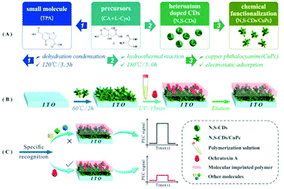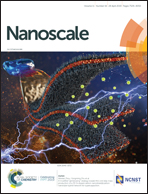A synergistic approach to enhance the photoelectrochemical performance of carbon dots for molecular imprinting sensors†
Abstract
Nanoscale carbon dots (CDs) have drawn increasing attention in photoelectrochemical (PEC) sensors for biotoxin detection owing to their many merits including excellent optical, electric and photoelectric properties. In this work, a novel strategy is proposed to improve the photoelectrical response performance of CDs by taking advantage of the synergistic effect of nitrogen and sulfur co-doping and copper phthalocyanine non-covalent functionalization approaches, which rightly adjusts the energy level of CDs, optimization of intimate interfacial contact, extension of the light absorption range, and enhancement of charge-transfer efficiency. This work demonstrates that heteroatom doping and chemical functionalization can endow CDs with various new and improved physicochemical, optical, and structural performances. This synergy contributes enormously to the molecular imprinting photoelectrochemical (MIP-PEC) sensor for toxin detection, and the work typically provided a wide linear range of 0.01 to 1000 ng mL−1 with a detection limit of 0.51 pg mL−1 for ochratoxin A (OTA).

- This article is part of the themed collection: Nanocarbons


 Please wait while we load your content...
Please wait while we load your content...